[vc_row type=”in_container” full_screen_row_position=”middle” scene_position=”center” text_color=”dark” text_align=”center” overlay_strength=”0.3″ shape_divider_position=”bottom” bg_image_animation=”none” shape_type=””][vc_column column_padding=”no-extra-padding” column_padding_position=”all” background_color_opacity=”1″ background_hover_color_opacity=”1″ column_link_target=”_self” column_shadow=”none” column_border_radius=”none” width=”1/1″ tablet_width_inherit=”default” tablet_text_alignment=”default” phone_text_alignment=”default” column_border_width=”none” column_border_style=”solid” bg_image_animation=”none”][vc_column_text]
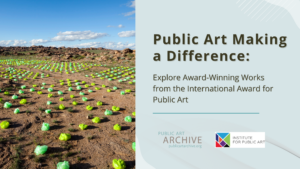
[/vc_column_text][/vc_column][/vc_row][vc_row type=”in_container” full_screen_row_position=”middle” scene_position=”center” text_color=”dark” text_align=”left” overlay_strength=”0.3″ shape_divider_position=”bottom” bg_image_animation=”none”][vc_column column_padding=”no-extra-padding” column_padding_position=”all” background_color_opacity=”1″ background_hover_color_opacity=”1″ column_link_target=”_self” column_shadow=”none” column_border_radius=”none” width=”1/1″ tablet_width_inherit=”default” tablet_text_alignment=”default” phone_text_alignment=”default” column_border_width=”none” column_border_style=”solid” bg_image_animation=”none”][vc_column_text]The Public Art Archive (PAA) is honored to partner with the Institute for Public Art to document and map the case studies from the International Award for Public Art (IAPA). The IAPA was created to bring visibility to public art projects of the highest achievement worldwide, focusing on art-led urbanism, place-making, community building, and social practice.
PAA’s collaboration with the IAPA enables unprecedented searchability and discoverability for global projects, creating access to data and stories detailing impactful public art. The IAPA is an ongoing effort — there is an open call for nominations for artworks that fit the global criteria. Learn more about the program, its award process, and the open call for nominations. [/vc_column_text][/vc_column][/vc_row][vc_row type=”in_container” full_screen_row_position=”middle” scene_position=”center” text_color=”dark” text_align=”left” overlay_strength=”0.3″ shape_divider_position=”bottom” bg_image_animation=”none”][vc_column column_padding=”no-extra-padding” column_padding_position=”all” background_color_opacity=”1″ background_hover_color_opacity=”1″ column_link_target=”_self” column_shadow=”none” column_border_radius=”none” width=”1/1″ tablet_width_inherit=”default” tablet_text_alignment=”default” phone_text_alignment=”default” column_border_width=”none” column_border_style=”solid” bg_image_animation=”none”][vc_custom_heading text=”The International Award for Public Art on PAA” use_theme_fonts=”yes”][vc_column_text]Over 100 artworks from across the globe have been added to PAA. As we continue to work toward archiving all of the researched artworks in the IAPA program, you can explore the artworks and filter by various facets, including regional collection, artwork type, material, placement, and theme. You can also explore artworks via PAA’s interactive map of the collection. In this post, we want to highlight just a few incredible artworks that have made a difference worldwide. [/vc_column_text][/vc_column][/vc_row][vc_row type=”in_container” full_screen_row_position=”middle” scene_position=”center” text_color=”dark” text_align=”left” overlay_strength=”0.3″ shape_divider_position=”bottom” bg_image_animation=”none”][vc_column column_padding=”no-extra-padding” column_padding_position=”all” background_color_opacity=”1″ background_hover_color_opacity=”1″ column_link_target=”_self” column_shadow=”none” column_border_radius=”none” width=”1/1″ tablet_width_inherit=”default” tablet_text_alignment=”default” phone_text_alignment=”default” column_border_width=”none” column_border_style=”solid” bg_image_animation=”none”][vc_custom_heading text=”Education – Literacy – Community Involvement” use_theme_fonts=”yes”][divider line_type=”No Line” custom_height=”25″][vc_row_inner column_margin=”default” text_align=”left”][vc_column_inner column_padding=”no-extra-padding” column_padding_position=”all” background_color_opacity=”1″ background_hover_color_opacity=”1″ column_shadow=”none” column_border_radius=”none” column_link_target=”_self” width=”1/6″ tablet_width_inherit=”default” column_border_width=”none” column_border_style=”solid” bg_image_animation=”none”][/vc_column_inner][vc_column_inner column_padding=”no-extra-padding” column_padding_position=”all” background_color_opacity=”1″ background_hover_color_opacity=”1″ column_shadow=”none” column_border_radius=”none” column_link_target=”_self” width=”2/3″ tablet_width_inherit=”default” column_border_width=”none” column_border_style=”solid” bg_image_animation=”none”][vc_column_text]
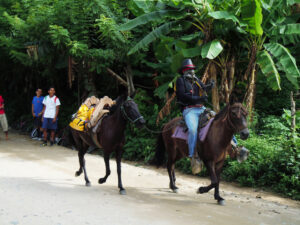
[/vc_column_text][/vc_column_inner][vc_column_inner column_padding=”no-extra-padding” column_padding_position=”all” background_color_opacity=”1″ background_hover_color_opacity=”1″ column_shadow=”none” column_border_radius=”none” column_link_target=”_self” width=”1/6″ tablet_width_inherit=”default” column_border_width=”none” column_border_style=”solid” bg_image_animation=”none”][/vc_column_inner][/vc_row_inner][vc_column_text]El Bibliobandido (The Book Bandit) is a participatory performance art piece designed to promote literacy in El Pital, Honduras. This unique work requires community members to interact with a masked character visiting their town requesting stories, and volunteers from the neighborhood to support and sustain the ongoing project.
Discover other examples of participatory art from the IAPA collection.
See more artworks from the IAPA collection promoting education and literacy.[/vc_column_text][/vc_column][/vc_row][vc_row type=”in_container” full_screen_row_position=”middle” scene_position=”center” text_color=”dark” text_align=”left” overlay_strength=”0.3″ shape_divider_position=”bottom” bg_image_animation=”none”][vc_column column_padding=”no-extra-padding” column_padding_position=”all” background_color_opacity=”1″ background_hover_color_opacity=”1″ column_link_target=”_self” column_shadow=”none” column_border_radius=”none” width=”1/1″ tablet_width_inherit=”default” tablet_text_alignment=”default” phone_text_alignment=”default” column_border_width=”none” column_border_style=”solid” bg_image_animation=”none”][vc_custom_heading text=”Community Development – Performance Spaces” use_theme_fonts=”yes”][divider line_type=”No Line” custom_height=”25″][vc_row_inner column_margin=”default” text_align=”left”][vc_column_inner column_padding=”no-extra-padding” column_padding_position=”all” background_color_opacity=”1″ background_hover_color_opacity=”1″ column_shadow=”none” column_border_radius=”none” column_link_target=”_self” width=”1/2″ tablet_width_inherit=”default” column_border_width=”none” column_border_style=”solid” bg_image_animation=”none”][vc_column_text]
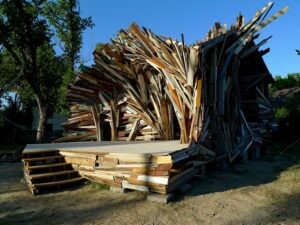
[/vc_column_text][/vc_column_inner][vc_column_inner column_padding=”no-extra-padding” column_padding_position=”all” background_color_opacity=”1″ background_hover_color_opacity=”1″ column_shadow=”none” column_border_radius=”none” column_link_target=”_self” width=”1/2″ tablet_width_inherit=”default” column_border_width=”none” column_border_style=”solid” bg_image_animation=”none”][vc_column_text]
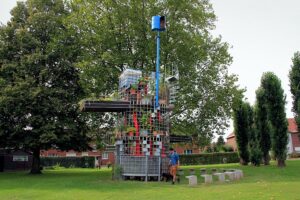
[/vc_column_text][/vc_column_inner][/vc_row_inner][vc_column_text]Community development is a theme seen in many IAPA artworks. Fifth Ward Jam in Houston, Texas, is a stunning example of an art installation and performance space. Fabricated from reclaimed wood and recycled materials, it serves as a catalyst to transform an empty neighborhood lot into a lively site of community events and festivals.
See more IAPA artworks supporting community development.[/vc_column_text][divider line_type=”No Line” custom_height=”25″][vc_column_text]In Belgium, Biodiversity Tower, a collaboration between SEADS, Kris Mys, and Compostmeesters Willebroek, is a sustainable art installation that promotes the preservation and improvement of biodiversity, described as a “hotel” for the reproduction of insects and plants. Despite the artwork’s ecologically-based theme, the site of the artwork uncovers the history and context of the area in the village of Willebroek, Belgium, the site of a Nazi concentration camp during WWII. A site of life and regeneration, this artwork counteracts the village’s past in a positive and affirming way.
Discover more IAPA artworks that focus on environmental themes.
See more IAPA artworks that incorporate plant materials. [/vc_column_text][/vc_column][/vc_row][vc_row type=”in_container” full_screen_row_position=”middle” scene_position=”center” text_color=”dark” text_align=”left” overlay_strength=”0.3″ shape_divider_position=”bottom” bg_image_animation=”none”][vc_column column_padding=”no-extra-padding” column_padding_position=”all” background_color_opacity=”1″ background_hover_color_opacity=”1″ column_link_target=”_self” column_shadow=”none” column_border_radius=”none” width=”1/1″ tablet_width_inherit=”default” tablet_text_alignment=”default” phone_text_alignment=”default” column_border_width=”none” column_border_style=”solid” bg_image_animation=”none”][vc_custom_heading text=”Indigenous – Way-Finding – Technology” use_theme_fonts=”yes”][divider line_type=”No Line” custom_height=”25″][vc_row_inner column_margin=”default” text_align=”left”][vc_column_inner column_padding=”no-extra-padding” column_padding_position=”all” background_color_opacity=”1″ background_hover_color_opacity=”1″ column_shadow=”none” column_border_radius=”none” column_link_target=”_self” width=”1/2″ tablet_width_inherit=”default” column_border_width=”none” column_border_style=”solid” bg_image_animation=”none”][vc_column_text]
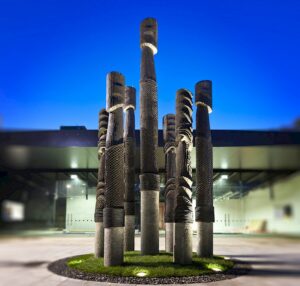
[/vc_column_text][/vc_column_inner][vc_column_inner column_padding=”no-extra-padding” column_padding_position=”all” background_color_opacity=”1″ background_hover_color_opacity=”1″ column_shadow=”none” column_border_radius=”none” column_link_target=”_self” width=”1/2″ tablet_width_inherit=”default” column_border_width=”none” column_border_style=”solid” bg_image_animation=”none”][vc_column_text]
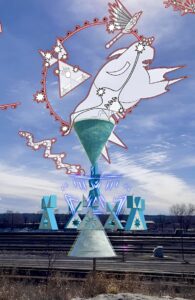
[/vc_column_text][/vc_column_inner][/vc_row_inner][vc_row_inner column_margin=”default” text_align=”left”][vc_column_inner column_padding=”no-extra-padding” column_padding_position=”all” background_color_opacity=”1″ background_hover_color_opacity=”1″ column_shadow=”none” column_border_radius=”none” column_link_target=”_self” width=”1/1″ tablet_width_inherit=”default” column_border_width=”none” column_border_style=”solid” bg_image_animation=”none”][vc_column_text]Pou Tu Te Rangi, a large-scale outdoor sculpture by Chris Bailey, uses a traditional art form from Māori culture to reference indigenous way-finding techniques in a now bustling city district in Auckland, New Zealand. In St. Paul, Minnesota, Dakota Spirit Walk, the 2024 IAPA winner by Marlena Myles in collaboration with Todd Boss, leverages augmented reality to highlight Indigenous stories and sites along a walking path in a nature sanctuary. In different yet equally impactful ways, these artworks bring living but often overshadowed cultures to the forefront of the viewer’s experience.
See more examples of IAPA artworks with Indigenous themes.[/vc_column_text][/vc_column_inner][/vc_row_inner][/vc_column][/vc_row][vc_row type=”in_container” full_screen_row_position=”middle” scene_position=”center” text_color=”dark” text_align=”left” overlay_strength=”0.3″ shape_divider_position=”bottom” bg_image_animation=”none”][vc_column column_padding=”no-extra-padding” column_padding_position=”all” background_color_opacity=”1″ background_hover_color_opacity=”1″ column_link_target=”_self” column_shadow=”none” column_border_radius=”none” width=”1/1″ tablet_width_inherit=”default” tablet_text_alignment=”default” phone_text_alignment=”default” column_border_width=”none” column_border_style=”solid” bg_image_animation=”none”][vc_custom_heading text=”Time-Based – Temporary – Art Festivals” use_theme_fonts=”yes”][divider line_type=”No Line” custom_height=”25″][vc_row_inner column_margin=”default” text_align=”left”][vc_column_inner column_padding=”no-extra-padding” column_padding_position=”all” background_color_opacity=”1″ background_hover_color_opacity=”1″ column_shadow=”none” column_border_radius=”none” column_link_target=”_self” width=”1/2″ tablet_width_inherit=”default” column_border_width=”none” column_border_style=”solid” bg_image_animation=”none”][vc_column_text]
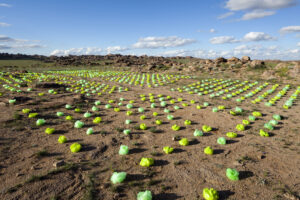
[/vc_column_text][/vc_column_inner][vc_column_inner column_padding=”no-extra-padding” column_padding_position=”all” background_color_opacity=”1″ background_hover_color_opacity=”1″ column_shadow=”none” column_border_radius=”none” column_link_target=”_self” width=”1/2″ tablet_width_inherit=”default” column_border_width=”none” column_border_style=”solid” bg_image_animation=”none”][vc_column_text]
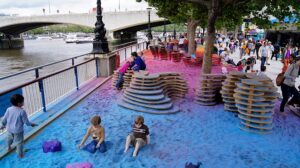
[/vc_column_text][/vc_column_inner][/vc_row_inner][vc_column_text]Many IAPA artworks are temporary installations, performances, or art interventions only intended to be installed or viewable for a limited time. Land Art Mongolia / LAM 360 is an example of a biennial event showcasing works that contend with the ecological crisis of Mongolia through temporary land art. Another example is Adam Kalinowski’s Rainbow Park, commissioned for the Southbank Centre’s Festival of the World in London in 2012. Using 50 tons of colored and plain sand and sculptures to resemble boulders, the interactive artwork installed along the Queen’s Walk from the London Eye to the Tate Modern, engaged viewers of all ages and backgrounds by providing seating areas, places to play, and spaces to rest and enjoy the colorful and imaginative surroundings.
Explore temporary IAPA artworks that are no longer on view in public space.[/vc_column_text][/vc_column][/vc_row][vc_row type=”in_container” full_screen_row_position=”middle” scene_position=”center” text_color=”dark” text_align=”left” overlay_strength=”0.3″ shape_divider_position=”bottom” bg_image_animation=”none”][vc_column column_padding=”no-extra-padding” column_padding_position=”all” background_color_opacity=”1″ background_hover_color_opacity=”1″ column_link_target=”_self” column_shadow=”none” column_border_radius=”none” width=”1/1″ tablet_width_inherit=”default” tablet_text_alignment=”default” phone_text_alignment=”default” column_border_width=”none” column_border_style=”solid” bg_image_animation=”none”][vc_column_text]The IAPA collection on PAA will continue to grow over the coming months as the team catalogs more projects. Check in often to discover works from the archive and new projects as future award winners are announced. View the complete listing of IAPA artworks on the Institute for Public Art’s website.[/vc_column_text][divider line_type=”No Line” custom_height=”25″][/vc_column][/vc_row]
